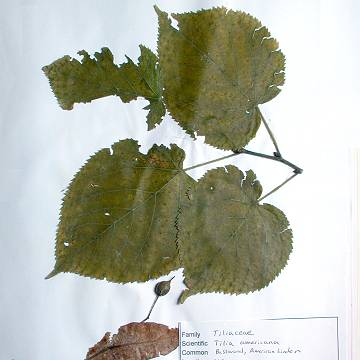

Tilia americana - (image 1 of 6)
Taxonomy
Family: Tiliaceae
Habitat
Dry and mesic woods. Found on high dunes facing Lake Michigan. Steep slopes of river and ravines.
Associates
Distribution
New Brunswick west to Manitoba, south to FL and TX; disjunct in Mexico.
Morphology
Deciduous tree to 40 m. Bark gray with dark furrows. Leaves alternate, palmately veined, broadly ovate or subrotund, sharply serrate, cordate or truncate at the base, petiolate. Flowers perfect, 5-merous, in axillary cymes on a long peduncle attached to about the middle of a narrow, elongate, short-petioled, foliaceous bract; sepals valvate, distinct; petals white, narrowly oblong to oblanceolate, 3-12 mm, tapering to the base; stamens numerous; stigma shallowly lobed; ovary tomentose, with 5 locules each containing 2 ovules. Fruit subglobose, nutlike, indehiscent, tomentose, 1-2 seeded, 6-8 mm.
Notes
Flowers mid June to mid July
Wetland indicator: Facultative Upland
Also called Basswood. The cultivar 'Redmond', which has a pyramidal shape, is shown in most of these images. The flowers smell very nice and are somewhat showy. Dried flowers can be used to make tea and the unopened leaf buds are mucilaginous and edible.
References
Gleason, Henry A. and A. Cronquist. 1991. Manual of Vascular Plants of Northeastern United States and Adjacent Canada. Second Ed.
The New York Botanical Garden. Bronx, NY
Peterson, L. A.
1977. A Field Guide to Edible Wild Plants: Eastern and central North America
Houghton Mifflin Company. New York, NY
Swink, F. and G. Wilhelm. 1994. Plants of the Chicago Region.
Indiana Academy of Science. The Morton Arboretum. Lisle, Illinois.
|
Michael Hough © 2005 |